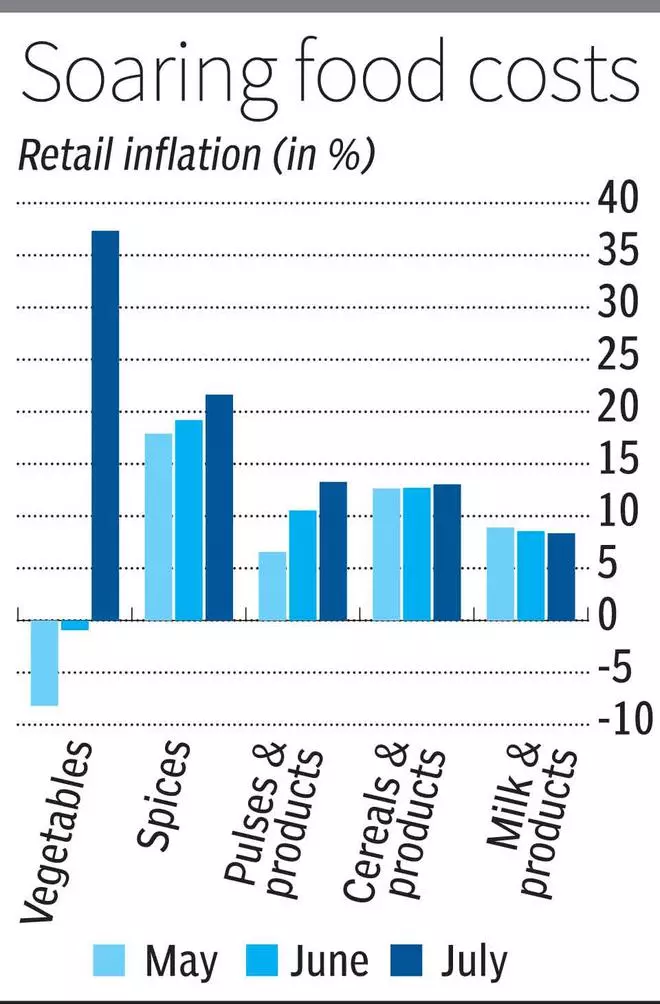Vegetables, spices, and cereals among other items pushed retail inflation based on Consumer Price Index (CPI) to a 14-month high of 7.4 per cent in July. However, despite higher prices of primary products such as agri produce, producers’ inflation based on Wholesale Price Index (WPI) remained in the negative zone at (-) 1.36 per cent in the same month.
Retail inflation rate and wholesale inflation rate were 4.9 per cent and (-) 4.12 per cent, respectively, in June. While retail inflation has breached the targeted range of 2-6 per cent after four months, the possibility of a rate hike is remote as it is estimated that such an action could take place after 6 per cent or more inflation in two successive quarters.
Costlier food items
Vegetables, with a weight of around 7 per cent, was the real culprit behind rise in print beyond expectation. While vegetable inflation was 37 per cent, spices flared the headline number. Inflation rate was around 22 per cent for spices. Along with these two, successive double-digit inflation for cereals (around 13 per cent) and persistent higher inflation of milk (8.3 per cent) contributed to the rise of not just food inflation but overall number. In fact, food inflation (11.5 per cent) jumped to a 39-month high.

The Monetary Policy Committee (MPC) had correctly gauged the impact of vegetable prices. In its resolution dated August 19, the MPC had said that going forward, the spike in vegetable prices, led by tomatoes, would exert sizeable upside pressure on the near-term headline inflation trajectory. This jump is, however, likely to correct with fresh market arrivals. There has been a significant improvement in the progress of the monsoon and kharif sowing in July. However, the impact of the uneven rainfall distribution warrants careful monitoring.
“Crude oil prices have firmed up amidst production cuts. Manufacturing, services and infrastructure firms polled in the Reserve Bank’s enterprise surveys expect input costs to ease but output prices to harden,” it said while revising annual inflation forecast to 5.4 per cent from 5.1 per cent.
Aditi Nayar, Chief Economist with ICRA, said while the MPC had emphasised the need to be vigilant and to be ready to act appropriately to ensure that the effects of shocks do not persist, the bar for a rate hike would be quite high. “In our view, inflation would need to persist above 6 per cent for at least two quarters amid transmission of pressures to core inflation to set the stage for a rate hike,” she said.
In a note, Paras Jasrai (Analyst) and Sunil K Sinha (Principal Economist) of India Ratings & Research, said core inflation is likely to hover around 4.7-4.9 per cent range in the foreseeable future given the stubborn nature of prices of items within core such as health, education, clothing & footwear and personal care & effects. “We, therefore, maintain our view of status quo on policy rates in FY24. However, the inflation excluding vegetables and fruits has remained in the 5-5.5 per cent range since April 2023 and this factor may prompt RBI to not raise policy rates,” the note said.
Wholesale inflation
On WPI, a statement released by the Commerce & Industry Ministry said: “Decline in the rate of inflation in July 2023 is primarily contributed by fall in prices of mineral oils, basic metals, chemical & chemical products, textiles and food products.”
Rajani Sinha, Chief Economist with CareEdge Ratings, said sequential momentum in WPI turned positive after two months. ”We expect the WPI inflation for this fiscal at a subdued level (in the range of 1-2 per cent) with positive implications for the retail inflation trajectory,” she said.








Comments
Comments have to be in English, and in full sentences. They cannot be abusive or personal. Please abide by our community guidelines for posting your comments.
We have migrated to a new commenting platform. If you are already a registered user of TheHindu Businessline and logged in, you may continue to engage with our articles. If you do not have an account please register and login to post comments. Users can access their older comments by logging into their accounts on Vuukle.